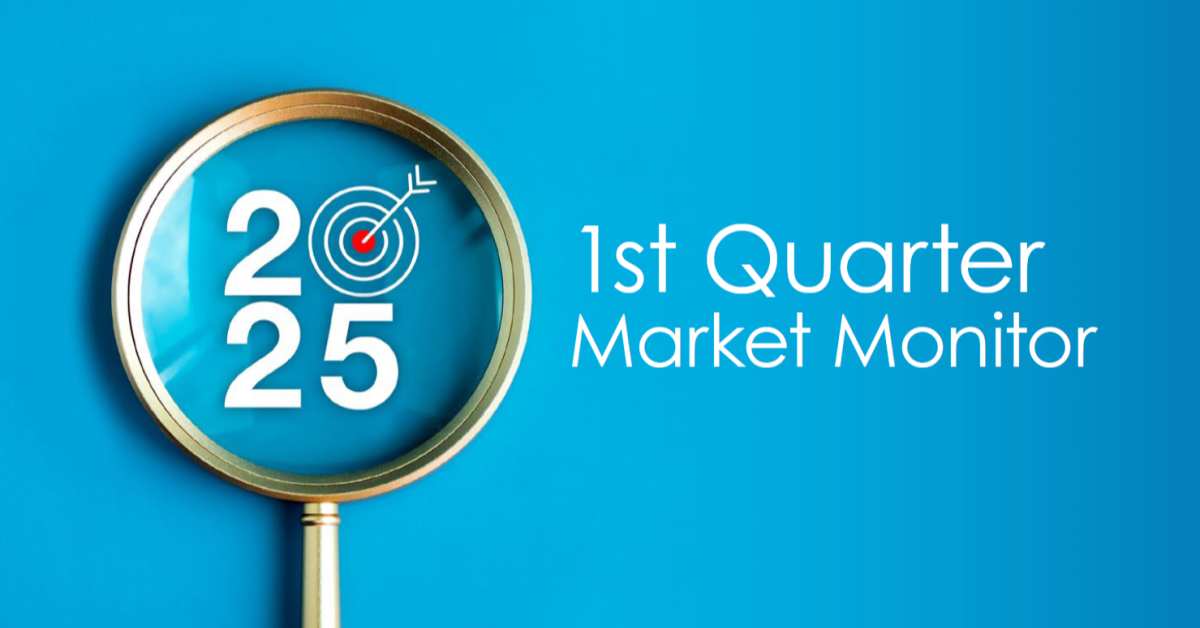Market Commentary
- The U.S. economy has defied investor expectations and remains resilient. U.S. GDP has grown above 2% in each of the last six quarters1 and the labor market continues to be strong. This fueled the equity market and “riskier” segments of fixed income, such as high yield. Valuations have moved higher on the back of strong price movement while earnings growth has been muted. Much of the valuation move can be attributed to the concentrated top constituents. Expectations are for positive earnings growth in Q1 (3.6%) and for calendar year 2024 (11%) but slimming margins may be a headwind.1
- Inflation moderated during the quarter but remains above the Federal Reserve’s 2% target. The shelter component has been a large factor of sticky inflation and the path to 2% from here may not be linear as inflation remains in a “messy middle” range of 2% to 5%.
- Expectations for Federal Reserve rate cuts shifted significantly in the first quarter. Entering 2024, the market was pricing in at least six rate cuts by the end of the year, but this shifted to only three by the time the quarter finished.1 Interest rates moved higher across the yield curve and fixed income came under pressure.
Fixed Income
- Shifting expectations of when the Federal Reserve will begin to cut interest rates was the main driver of the move higher in interest rates during the quarter and, as a result, the Bloomberg U.S. Aggregate Bond Index lost 0.8% in the first three months of the year.1 The U.S. Treasury curve steepened (10s-2s spread) but remains inverted. Fixed income yields remain attractive across most sectors.
- Spread sectors, for the most part, generally outpaced similar duration Treasuries in the quarter. A resilient economy, favorable corporate fundamentals and strong demand have provided a tailwind for corporate credit, notably high yield. Valuations appear full as spreads continued to compress and now sit at levels below longer-term averages. The U.S. Corporate High Yield Index returned 1.5% in the quarter and 11.2% over the trailing 12 months.1
Equity
- Domestic equity markets had favorable results in Q1 2024. The S&P 500 Index touched new highs and had its best start to the year since 2019, returning 10.6%.1 Concentrated leadership within the large cap index remains with four constituents (Nvidia, Meta, Microsoft, and Amazon) accounting for 45% of the gain. U.S. small cap stocks (Russell 2000 Index) also had a positive quarter, increasing 5.2%.1
- International equity markets also had positive returns in the first quarter. Developed markets benefited from strong results in Japan and softening inflation in Europe; the MSCI EAFE Index gained 5.8%.1 Stabilizing economic growth in Japan, corporate governance reform and a declining yen were tailwinds for the country. Emerging economies (MSCI EM) trailed developed markets, returning 2.4%.1 China continues to underwhelm as economic growth remains anemic and uncertainty around the real estate market remains.
Real Assets
- Rising interest rates were a headwind for REITs and the FTSE NAREIT Equity REITs Index fell 0.2%.1 The AI craze was a tailwind for the data center sub-sector, and advertising related constituents buoyed the specialty sub-sector, while self-storage and diversified were notable areas of weakness.
- The Bloomberg Commodity Index rose 2.2% in the first quarter.1 The energy and precious metal sub-components had a positive impact on the asset class. Supply disruptions and geopolitical unrest contributed to rising energy and metal prices.
1. Fiducient Advisors Quarterly Considerations March 31, 2024
2. Fiducient Advisors Market Insights March 31, 2024
This report is intended for the exclusive use of clients or prospective clients (the “recipient”) of HCR Wealth Advisors and the information contained herein is confidential and the dissemination or distribution to any other person without the prior approval of HCR Wealth Advisors is strictly prohibited. Information has been obtained from sources believed to be reliable, though not independently verified. Any forecasts are hypothetical and represent future expectations and not actual return volatilities and correlations will differ from forecasts. This report does not represent a specific investment recommendation. The opinions and analysis expressed herein are based on HCR Wealth Advisors’ research and professional experience and are expressed as of the date of this report. Please consult with your advisor, attorney and accountant, as appropriate, regarding specific advice. Past performance does not indicate future performance and there is risk of loss.
Comparisons to any indices referenced herein are for illustrative purposes only and are not meant to imply that actual returns or volatility will be similar to the indices. Indices cannot be invested in directly. Unmanaged index returns assume reinvestment of any and all distributions and do not reflect our fees or expenses.
Bloomberg Aggregate Bond Index covers the U.S. investment grade fixed rate bond market, with index components for government and corporate securities, mortgage pass-through securities, and asset-backed securities.
Bloomberg US Corporate High Yield Index covers the universe of fixed rate, non-investment grade debt. Eurobonds and debt issues from countries designated as emerging markets (sovereign rating of Baa1/BBB+/BBB+ and below using the middle of Moody’s, S&P, and Fitch) are excluded, but Canadian and global bonds (SEC registered) of issuers in non-EMG countries are included.
S&P 500 Index is a capitalization-weighted index designed to measure performance of the broad domestic economy through changes in the aggregate market value of 500 stocks representing all major industries.
Russell 2000 Index consists of the 2,000 smallest U.S. companies in the Russell 3000 index.
MSCI EAFE Index is an equity index which captures large and mid-cap representation across Developed Markets countries around the world, excluding the U.S. and Canada. The index covers approximately 85% of the free float-adjusted market capitalization in each country.
MSCI Emerging Markets Index captures large and mid-cap representation across Emerging Markets countries. The index covers approximately 85% of the free-float adjusted market capitalization in each country.
Bloomberg Commodity Index is calculated on an excess return basis and reflects commodity futures price movements. The index rebalances annually weighted 2/3 by trading volume and 1/3 by world production and weight-caps are applied at the commodity, sector and group level for diversification.
FTSE Nareit Equity REITs Index contains all Equity REITs not designed as Timber REITs or Infrastructure REITs.
Material Risks Disclosures
Fixed Income securities are subject to interest rate risks, the risk of default and liquidity risk. U.S. investors exposed to non-U.S. fixed income may also be subject to currency risk and fluctuations.
Domestic Equity can be volatile. The rise or fall in prices take place for a number of reasons including, but not limited to changes to underlying company conditions, sector or industry factors, or other macro events. These may happen quickly and unpredictably.
International Equity can be volatile. The rise or fall in prices take place for a number of reasons including, but not limited to changes to underlying company conditions, sector or industry impacts, or other macro events. These may happen quickly and unpredictably. International equity allocations may also be impact by currency and/or country specific risks which may result in lower liquidity in some markets.
Real Assets can be volatile and may include asset segments that may have greater volatility than investment in traditional equity securities. Such volatility could be influenced by a myriad of factors including, but not limited to overall market volatility, changes in interest rates, political and regulatory developments, or other exogenous events like weather or natural disaster.



